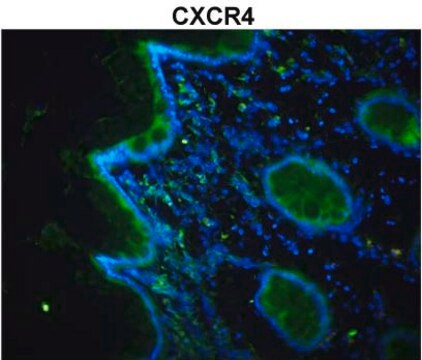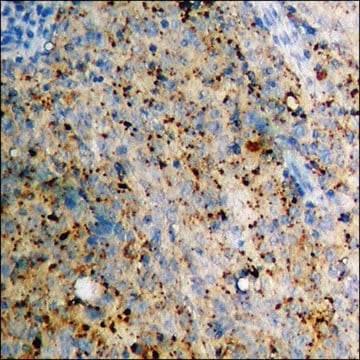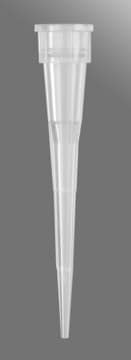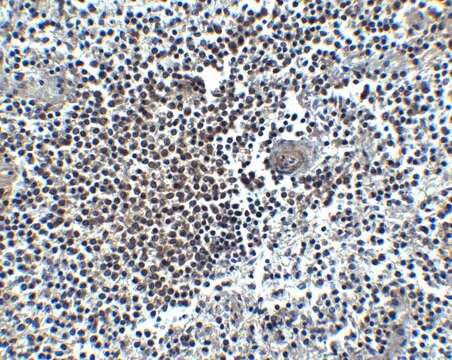AB1847
Anti-C-X-C Chemokine Receptor 4 Antibody, extracellular loop
Chemicon®, from rabbit
Synonym(s):
CD184, CXCR4
Sign Into View Organizational & Contract Pricing
All Photos(1)
About This Item
UNSPSC Code:
12352203
eCl@ss:
32160702
NACRES:
NA.41
Recommended Products
biological source
rabbit
Quality Level
antibody form
purified immunoglobulin
antibody product type
primary antibodies
clone
polyclonal
species reactivity
human, mouse
manufacturer/tradename
Chemicon®
technique(s)
western blot: suitable
NCBI accession no.
UniProt accession no.
shipped in
wet ice
target post-translational modification
unmodified
Gene Information
human ... CXCR4(7852)
Specificity
Some G protein-coupled receptors including CCR5, CXCR4, CCR3, CCR2b and CCR8 in the chemokine receptor family, and four new human molecules GPR15, STRL33, GPR1 and V28 were recently identified as HIV coreceptors (Nimitrov 1997). Among them, CXCR4 (fusin, LESTR or HUMSTR) is a principle coreceptor for T-cell tropic strains of HIV-1 fusion and entry of human white blood cells (Feng et al. 1996; Berson et al. 1996). CXCR4 is also required for the infection by dual-tropic strains of HIV-1 and mediates CD-4 independent infection by HIV-2 (Doranz et al. 1996; Endres et al. 1996). The a-chemokine SDF-1 is the ligand for CXCR4 and prevents infection by T-tropic HIV-1 (Bleul et al. 1996; Oberlin et al. 1996). CXCR4 associates with the surface CD4-gp120 complex before HIV enters target cells (Lapham et al. 1996). CXCR4 messenger RNA levels correlated with HIV-1 permissiveness in diverse human cell types (Feng et al. 1996). Antibodies to CXCR4 block HIV-1 and HIV-2 fusion and infection of human target cells (Feng et al. 1996; Endres et al. 1996; Brelot et al. 1997). The amino-terminal domain and the second extracellular loop of CXCR4 serve as HIV binding sites (Brelot et al. 1997; Lu et al. 1997).
Immunogen
Epitope: extracellular loop
Extracellular loop peptide of human CXCR4 (Berson et al. 1996; Leotscher et al. 1994).
Application
Anti-C-X-C Chemokine Receptor 4 Antibody, extracellular loop detects level of C-X-C Chemokine Receptor 4 & has been published & validated for use in WB.
Research Category
Inflammation & Immunology
Inflammation & Immunology
Research Sub Category
Cytokines & Cytokine Receptors
Cytokines & Cytokine Receptors
Western blot: 1:500 - 1000
Optimal working dilutions must be determined by end user.
Optimal working dilutions must be determined by end user.
Physical form
Format: Purified
Purified IgG in PBS containing 0.02% sodium azide.
Storage and Stability
Can be refrigerated at 2-8°C in undiluted aliquots for up to 12 months from date of receipt.
Legal Information
CHEMICON is a registered trademark of Merck KGaA, Darmstadt, Germany
Disclaimer
Unless otherwise stated in our catalog or other company documentation accompanying the product(s), our products are intended for research use only and are not to be used for any other purpose, which includes but is not limited to, unauthorized commercial uses, in vitro diagnostic uses, ex vivo or in vivo therapeutic uses or any type of consumption or application to humans or animals.
Not finding the right product?
Try our Product Selector Tool.
Storage Class Code
10 - Combustible liquids
WGK
WGK 2
Flash Point(F)
Not applicable
Flash Point(C)
Not applicable
Certificates of Analysis (COA)
Search for Certificates of Analysis (COA) by entering the products Lot/Batch Number. Lot and Batch Numbers can be found on a product’s label following the words ‘Lot’ or ‘Batch’.
Already Own This Product?
Find documentation for the products that you have recently purchased in the Document Library.
CXCR4 attenuates cardiomyocytes mitochondrial dysfunction to resist ischaemia-reperfusion injury.
Cai, WF; Kang, K; Huang, W; Liang, JL; Feng, YL; Liu, GS; Chang, DH; Wen, ZL; Paul, C; Xu et al.
Journal of Cellular and Molecular Medicine null
Chih-Hung Guo et al.
Marine drugs, 19(4) (2021-04-04)
Fish oil (FO) and selenium (Se) possess antiangiogenic potential in malignant tumors. This study aimed to determine whether combination of FO and Se enhanced treatment efficacy of low-dose antiangiogenic agent Avastin (bevacizumab) in a dose-dependent manner and targeted multiple signaling
Akt/hypoxia-inducible factor-1? signaling deficiency compromises skin wound healing in a type 1 diabetes mouse model.
Jing, L; Li, S; Li, Q
Experimental and Therapeutic Medicine null
Yung-Ming Chang et al.
Journal of cellular physiology, 234(7), 12042-12050 (2018-12-06)
Adipose-derived mesenchymal stem cells (ADMSCs) are easily accessible and are attractive mesenchymal stem cells for use in regenerative medicine; however their application is frequently restricted due to various challenges present in the environment they are administered. Therefore ADMSCs are preferably
Heidi Schabath et al.
Journal of cell science, 119(Pt 2), 314-325 (2006-01-05)
CD24 is a small, heavily glycosylated cell-surface protein which is linked to the membrane via a glycosyl-phosphatidylinositol (GPI-) anchor and therefore localizes in lipid rafts. CD24 is widely used as a cell-lineage marker for hematopoietic cells. CD24 is also expressed
Our team of scientists has experience in all areas of research including Life Science, Material Science, Chemical Synthesis, Chromatography, Analytical and many others.
Contact Technical Service







